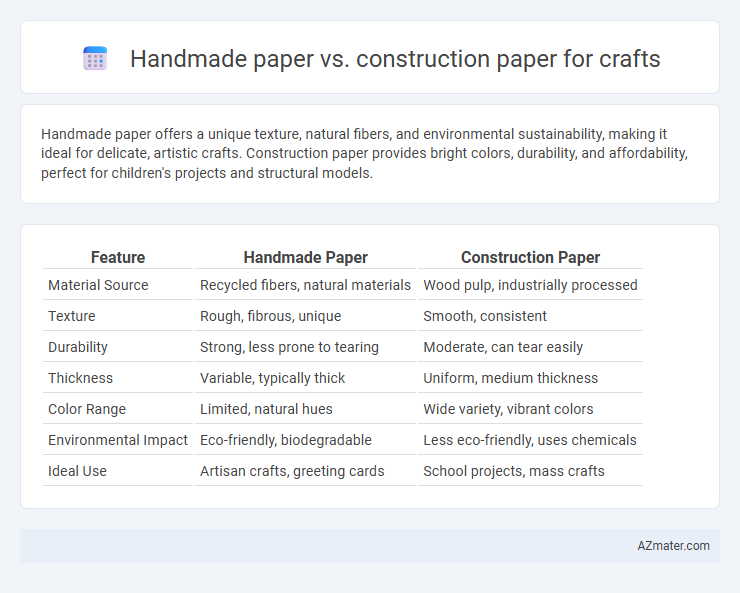Handmade paper offers a unique texture, natural fibers, and environmental sustainability, making it ideal for delicate, artistic crafts. Construction paper provides bright colors, durability, and affordability, perfect for children's projects and structural models.
Table of Comparison
| Feature | Handmade Paper | Construction Paper |
|---|---|---|
| Material Source | Recycled fibers, natural materials | Wood pulp, industrially processed |
| Texture | Rough, fibrous, unique | Smooth, consistent |
| Durability | Strong, less prone to tearing | Moderate, can tear easily |
| Thickness | Variable, typically thick | Uniform, medium thickness |
| Color Range | Limited, natural hues | Wide variety, vibrant colors |
| Environmental Impact | Eco-friendly, biodegradable | Less eco-friendly, uses chemicals |
| Ideal Use | Artisan crafts, greeting cards | School projects, mass crafts |
Introduction to Handmade and Construction Paper
Handmade paper is crafted using natural fibers such as cotton, hemp, or recycled materials, offering a textured surface ideal for artistic and eco-friendly projects. Construction paper, composed primarily of wood pulp and dyed with vibrant pigments, provides a smooth, sturdy base commonly used in school crafts and basic art projects. The unique fiber composition and production methods of handmade paper result in a distinctive feel and appearance, contrasting with the mass-produced, uniform quality of construction paper.
What is Handmade Paper?
Handmade paper is crafted by manually pulping plant fibers or recycled materials, resulting in a textured, organic surface ideal for artistic and eco-friendly crafts. Unlike smooth, machine-produced construction paper, handmade paper offers unique variations in thickness and fiber distribution, enhancing the tactile and visual appeal of handmade projects. This artisanal quality makes handmade paper preferred for specialty crafts, calligraphy, and decorative arts where texture and sustainability are important.
What is Construction Paper?
Construction paper is a durable, colored paper commonly used in crafts and school projects, made from wood pulp and often dyed in bright, vibrant colors. It has a rough texture and is thicker than regular paper but thinner than cardstock, making it easy to cut, fold, and glue. Unlike handmade paper, construction paper is mass-produced, uniform in size and color, and designed for affordability and ease of use in various creative applications.
Material Composition: Handmade vs Construction Paper
Handmade paper is typically composed of natural fibers such as cotton, linen, or recycled materials, resulting in a textured, durable surface ideal for artistic crafts and unique projects. Construction paper, made from wood pulp and often colored with synthetic dyes, offers a smoother, less absorbent finish suited for mass-produced crafts and children's projects. The distinct material composition of handmade paper provides enhanced strength and organic appeal, while construction paper ensures affordability and vibrant color variety for general crafting needs.
Texture and Appearance Comparison
Handmade paper exhibits a distinct, rough texture with natural fibers and irregular edges, offering an organic, artisanal appearance ideal for premium crafts and invitations. Construction paper features a smooth, uniform surface with vibrant colors and consistent thickness, making it suitable for everyday school projects and easy cutting. The tactile feel of handmade paper enhances the sensory experience, while construction paper provides durability and bright visual impact for diverse crafting purposes.
Durability and Strength in Crafts
Handmade paper exhibits superior durability and strength compared to construction paper, making it ideal for intricate craft projects requiring long-lasting material. Its dense fiber composition provides enhanced resistance to tearing and wear, ensuring crafts maintain structural integrity over time. Construction paper, although flexible and economical, tends to be thinner and less resilient, making it more suitable for temporary or less demanding craft applications.
Environmental Impact and Sustainability
Handmade paper, often produced from recycled fibers and natural materials, offers a significantly lower environmental impact compared to construction paper, which is typically manufactured using energy-intensive processes and may contain synthetic additives. The biodegradability and reduced chemical usage in handmade paper contribute to its sustainability, making it a preferred choice for eco-conscious craft projects. Construction paper, while versatile and widely available, generally lacks the eco-friendly attributes inherent in handmade options, leading to higher waste and pollution concerns.
Cost and Availability for Crafters
Handmade paper typically costs significantly more than construction paper due to the labor-intensive production process and use of natural fibers, making it less accessible for budget-conscious crafters. Construction paper is widely available in most craft stores and supermarkets at affordable prices, providing a practical option for mass projects and educational use. The choice depends on balancing the premium quality and unique texture of handmade paper against the economical bulk availability of construction paper.
Best Uses for Handmade Paper in Crafts
Handmade paper excels in craft projects requiring unique textures, organic aesthetics, and eco-friendly materials, making it ideal for scrapbooking, card making, and invitations. Its irregular fibers and natural colors add artistic value to mixed media art, collage work, and decorative packaging. Lightweight yet durable, handmade paper enhances craft projects that emphasize originality and artisanal appeal.
Best Uses for Construction Paper in Crafts
Construction paper is ideal for vibrant, cost-effective craft projects due to its bright colors and easy-to-cut texture, making it perfect for children's art, paper folding, and collage work. Its durability and thickness provide sturdy bases for cards, decorations, and school projects that require more structure than lightweight paper. Unlike handmade paper, construction paper offers consistent quality and smooth surfaces that enhance marker and crayon work for detailed illustrations and cutting precision.

Infographic: Handmade paper vs Construction paper for Craft
 azmater.com
azmater.com